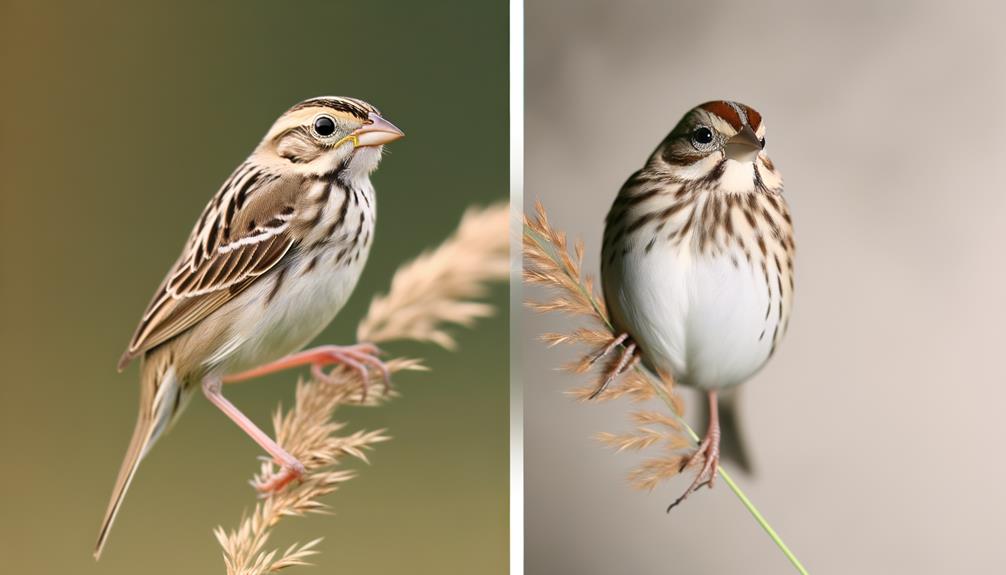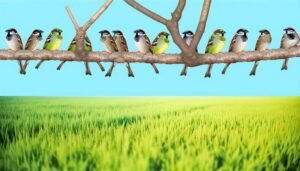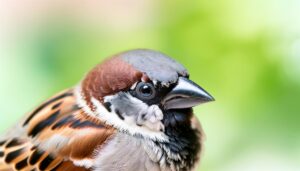Grasshopper Sparrow Vs Savannah Sparrow – 7 Key Differences
Grasshopper Sparrows and Savannah Sparrows often share similar habitats and eat similar food, but they're quite different birds. Grasshopper Sparrows are shorter, with sturdy wings and a yellow eye patch, while Savannah Sparrows are taller and use plumage to blend into their surroundings.
Grasshopper Sparrows prefer open fields with tall grass and perform a 'broken-wing' act to distract predators, while Savannah Sparrows have rich, complex songs and resort to mobbing behavior. Delving deeper into their lifestyles, one would reveal a fascinating world of avian intricacies.

Key Takeaways
- Grasshopper Sparrows have a compact body with a distinct yellow eye patch, while Savannah Sparrows have brown and grey upperparts with streaked breasts.
- Grasshopper Sparrows prefer grassland ecosystems and open fields, while Savannah Sparrows adapt to various habitats but are impacted by habitat loss.
- Grasshopper Sparrows have an insect-like trilling song, whereas Savannah Sparrows are known for their rich and complex songs.
- Both species feed primarily on insects and seeds, but Grasshopper Sparrows have a special preference for grasshoppers.
- Grasshopper Sparrows exhibit a 'broken-wing' act to distract predators, while Savannah Sparrows show mobbing behavior against threats.
Physical Features of Grasshopper Sparrow
Sporting a compact body, the Grasshopper Sparrow is distinguished by its flat-headed appearance, buffy underparts, and a distinctive yellow patch near the eye.
Its name reflects the insect-like trilling song it produces, a sound that's often mistaken for that of a grasshopper.
The bird's back is streaked with brown and black, aiding in camouflage within its grassy environs.
Its wings are short, sturdy, and adapted for short, rapid flights. The tail is relatively short and typically held upright.
The beak, perfectly evolved for seed consumption, is conical and strong, with a pinkish hue at the base fading to a dark tip.
Averaging around 12-13 cm in length, this bird's small stature doesn't diminish its distinctive and intriguing presence in the avian world.
Grasshopper Sparrow's Preferred Habitats
The Grasshopper Sparrow, true to its namesake, is intricately linked to grassland ecosystems. These birds express a high preference for open, expansive fields, where they can nest and hunt within the tall grasses.
However, the Grasshopper Sparrow's habitat can undergo significant shifts with the changing seasons, suggesting a remarkable adaptability to their environment.
Grassland Necessities
Nestled in the open grasslands, Grasshopper Sparrows show a marked preference for habitats with tall, dense grass, sparse shrubbery, and minimal tree cover. This preference is driven by three primary factors:
- Food Availability: Grasshopper Sparrows primarily feed on insects and seeds, which are abundant in grassland environments.
- Nesting Sites: The dense grass provides ideal conditions for nest building, offering these sparrows protection from predators and harsh weather conditions.
- Territory Marking: Sparse shrubbery and minimal tree cover allow for easy visibility, aiding in territory demarcation and mate attraction.
Thus, Grassland Necessities aren't just preferences, but essential survival factors for Grasshopper Sparrows.
Understanding these necessities provides deeper insight into their habitat needs, contributing to effective conservation efforts.
Seasonal Habitat Shifts
Shifting with the seasons, Grasshopper Sparrows adapt their habitat preferences, showcasing a fascinating flexibility in their survival strategies.
During the breeding season, they favor grasslands with diverse vegetation structure, particularly those with taller grasses and scattered shrubs. These habitats offer ideal spots for nesting and ample insect prey for their young.
Come winter, they're more adaptable, often shifting to agricultural fields, pastures, and even scrublands. These habitats provide ample seeds for their diet and more cover from predators and harsh weather.
Understanding these seasonal shifts is critical for their conservation. By protecting a range of habitats, we safeguard the Grasshopper Sparrow's food sources, nesting sites, and survival throughout the year.
Unique Behaviors of Grasshopper Sparrow
Despite its small size, the Grasshopper Sparrow displays a variety of distinctive behaviors, including a captivating, insect-like song that sets it apart from other sparrows. This song, a rapid, high-pitched trill, mimics the sound of a grasshopper. It's their unique way of announcing territory or attracting a mate.
The Grasshopper Sparrow's song isn't its only remarkable behavior. They also exhibit a 'mouse-like' movement pattern. They prefer to scuttle through grass rather than fly, making them difficult to spot.
These sparrows are also solitary nesters. Unlike many other bird species, they avoid forming colonies and prefer their own company.
Remarkably, they perform a 'broken-wing' act when predators approach their nest, feigning injury to distract the predator and protect their young.
These behaviors make the Grasshopper Sparrow a captivating study.
Diet and Hunting Techniques of Grasshopper Sparrow
What does the Grasshopper Sparrow like to munch on, you might wonder? This bird's diet primarily consists of insects, particularly grasshoppers, from which it gets its name. However, it's not averse to supplementing its diet with seeds, especially during the colder months.
As for hunting techniques, the Grasshopper Sparrow employs stealth and precision. It's known to skulk through the grasslands, using its sharp eyesight to pinpoint its prey. Once spotted, it pounces, capturing its meal with a swift and accurate peck of its beak. Occasionally, it will take short flights to snap up insects mid-air.
This combination of hunting strategies ensures that the Grasshopper Sparrow's diet is diverse, keeping it nourished throughout the year.
Physical Features of Savannah Sparrow
A closer look at the Savannah Sparrow reveals a fascinating mosaic of physical features tailored to its lifestyle and habitat. This bird showcases an intriguing blend of colors, from its brown and grey upperparts to its white underparts streaked with brown.
To add depth, let's consider three of its most distinctive features:
- Size and Shape: The Savannah Sparrow stands at a modest 4.3 to 5.9 inches tall, with rounded wings and a notched tail. Its small stature doesn't hold it back in the least.
- Bill: Its short, stout bill is perfect for cracking open seeds, one of its primary food sources.
- Plumage: The Savannah Sparrow's plumage helps it blend seamlessly into its environment, with its streaked breast and crisp white belly.
These physical attributes contribute to the Savannah Sparrow's resilience and adaptability.
Savannah Sparrow's Preferred Habitats
The Savannah Sparrow exhibits a wide range of habitat choices, demonstrating its adaptability to diverse environments. From grassy meadows to marshlands, it's not uncommon to spot this bird thriving in various locales.
However, the impact of habitat loss presents a significant challenge to the Savannah Sparrow, a topic warranting further exploration.
Savannah Sparrow's Habitat Choices
Despite its name suggesting a proclivity for savannahs, the Savannah Sparrow actually prefers a diverse range of habitats, showing a marked preference for open areas with low vegetation, including grasslands and agricultural fields.
Grasslands:
These open, vast spaces with low vegetation provide the Savannah Sparrow with ample room for foraging and nesting.
Agricultural Fields:
Often, these sparrows can be found in areas cultivated by humans, where they can take advantage of the low-growing crops and insects that such fields attract.
Coastal Areas:
Surprisingly, Savannah Sparrows also adapt well to coastal areas, where they can utilize beach grasses and dunes for shelter and foraging.
These habitat choices not only offer the Savannah Sparrow a variety of food sources but also provide suitable conditions for nesting and rearing their young.
Adaptation to Diverse Environments
In adapting to a wide array of environments, Savannah Sparrows have developed certain distinct behaviors and characteristics that allow them to thrive in varying conditions, from grasslands and agricultural fields to coastal areas. They utilize their versatile diet, primarily composed of insects, seeds, and berries, to adapt to different habitats.
Their physical attributes also play a significant role. Their sturdy legs and sharp beaks are ideal for foraging on the ground in grassland or field settings, while their brown streaked plumage provides excellent camouflage in these environments.
| Habitat | Adaptation |
|---|---|
| Grasslands | Ground foraging, Camouflage |
| Agricultural fields | Versatile diet, Ground foraging |
| Coastal areas | Seeds and berries diet, Sturdy legs |
The Savannah Sparrow's adaptability showcases the resilience and versatility of this species.
Impact of Habitat Loss
While Savannah Sparrows have shown remarkable adaptability in different habitats, it's worth noting the impact habitat loss can have on this resilient species.
Loss of Food Sources:
As their preferred habitats shrink, Savannah Sparrows face a notable reduction in food sources. This can lead to decreased fitness and reproductive success.
Increased Vulnerability:
Habitat loss also means fewer places to hide from predators. This can increase mortality rates and impact the overall population size.
Restricted Breeding:
Without sufficient habitat, breeding becomes challenging. Savannah Sparrows need ample space for nesting and rearing their young. Habitat loss can notably limit these essential activities.
Unique Behaviors of Savannah Sparrow
Savannah Sparrows possess a remarkable array of behaviors that set them apart in the bird world. Renowned for their rich and complex songs, they're known to weave their own unique melodies into the repertoire. It's a skill that's unusual among sparrows, demonstrating their exceptional adaptability and intelligence.
Remarkably, they also exhibit a behavior known as 'mobbing'. When a predator ventures too close to their nest, they'll band together, aggressively dive-bombing the intruder. They're courageous, unafraid of defending their territory.
Males, in particular, display intriguing mating behaviors. They'll fluff their feathers and perform an enchanting dance to attract females. These performances are often accompanied by their unique songs, creating a spectacle that's truly a sight to behold in the avian world.
Diet and Hunting Techniques of Savannah Sparrow
Switching gears to their dietary habits, Savannah Sparrows primarily feed on insects and seeds, employing intriguing hunting techniques to secure their meals. They're not just indiscriminate eaters, but rather savvy hunters with a keen eye and quick reflexes.
- Seed Selection: Savannah Sparrows have a preference for small seeds. These birds are selective, opting for seeds rich in nutrients, particularly during the colder months when food is scarce.
- Insect Hunting: They chase after flying insects with agility, capturing their prey mid-flight. Additionally, they scour the ground, flipping over leaves and debris to unearth hidden insects.
- Grit Consumption: Interestingly, they also consume small pebbles or grit, aiding in the grinding down of hard seed coatings in their gizzard, thereby facilitating digestion.
Comparing Grasshopper and Savannah Sparrows
Now, let's draw comparisons between the Grasshopper Sparrow and the Savannah Sparrow, two species that, despite sharing similar habitats, exhibit distinct characteristics and behaviors. These two sparrows, while they might seem similar at first glance, have unique traits that set them apart. The Grasshopper Sparrow is known to be elusive, often hiding in tall grasses, while the Savannah Sparrow is more visible, often perching on fences or shrubs.
Here's a quick reference table:
| Feature | Grasshopper Sparrow | Savannah Sparrow |
|---|---|---|
| Size | Smaller | Larger |
| Color | Dull brown | Brown with streaks |
| Habitat | Grasslands | Open fields, marshes |
| Song | Insect-like buzz | Short, high-pitched notes |
| Diet | Seeds & insects | Mostly insects |
Understanding these differences can aid in correct field identification of these charming birds.
Conclusion
In the grand orchestra of nature, the Grasshopper and Savannah Sparrows play unique yet harmonious roles. They're both artists of survival, painting vivid strokes in their respective habitats.
The Grasshopper Sparrow, a secretive ground-dweller, contrasts with the Savannah Sparrow's open-field preference. Their diets, behaviors, and physical traits are different verses of the same song – survival.
Understanding these two species is like revealing a musical score, each note disclosing more about their life's symphony.






